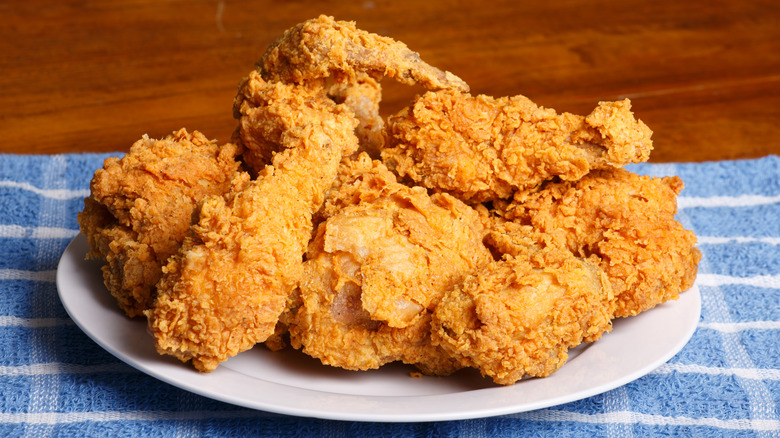The Foil Mistake You Need To Avoid To Keep Fried Chicken Crispy
One of the great challenges of cooking large meals for lots of people is timing. For the best culinary experience, every plate needs to be served hot — but if you're dishing out servings for a crowd and have limited space (read: not a professional kitchen), that can be nearly impossible. Your pots are only so large, you have only so many burners, and the oven has only so much space. Cooking in batches is necessary.
For many dishes, the easy solution to keep food warm while it waits is to wrap it in foil. Cover the top of a pan or create a foil pocket and all that heat is locked in. Not so with crispy fried chicken. There are lots of mistakes you need to avoid when frying chicken, but once it's been fried, a little work is still required to maintain the crunchy breading texture. If you wrap foil tightly around fried chicken (like you would if a roast needs to be kept warm), the poultry may stay warm but the crispy skin is going to get soggy. That's because the steam that's still escaping from the hot food gets trapped in the sealed foil, and the water vapor being released has nowhere to settle — except on your fried chicken's previously crispy skin.
Reduce the moisture to keep the crunch
The foil problem isn't insurmountable, though, and you don't have to toss the tool entirely. If you want to perfectly fry chicken for a crowd and need a large time window to keep the batches warm, you can station the first rounds of finished chicken in the oven and cover the chicken in a foil tent — not wrapped tightly but lightly, leaving open areas for steam to escape. The oven should be set to a very low temperature, around 200 to 250 degrees Fahrenheit, so that the chicken doesn't become overcooked. It can stay in the oven like this for up to two hours, with the breading keeping its much-desired crispiness while still guaranteeing your fried chicken is juicy.
If you have one handy, it's also best to place the chicken on a wire rack in a sheet pan during the oven-warming process. These cooling racks are designed to allow for air circulation all around the food, thus cooling it more quickly and keeping steam from getting trapped underneath. In this case, the cooling rack will give any remaining oil a place to drip off and the full airflow will prevent a soggy bottom on your fried chicken.
Warming leftover fried chicken
Although this oven method is a great solution for freshly fried chicken, it won't help you when it comes to leftovers. The low, slow method will take a long time and likely dry out your chicken in the process. Instead, if you've got leftover fried chicken and you're opting for oven reheating, you need high heat for a short time.
Start by bringing the chicken up to room temperature, letting it sit outside the refrigerator for about half an hour. In the meantime, preheat your oven to 400 degrees Fahrenheit, and when it's ready, place the fried chicken on a wire rack in a sheet pan and cook it for about 15 minutes. By then, your chicken will be hot and its breading will be perfectly crisp.
It may be tempting to reach for the microwave door, but fried chicken leftovers are worth the extra time. Because they heat by vibrating water molecules, microwaves tend to bring moisture to the surface — and in fried chicken, that's exactly where you don't want moisture to be.


